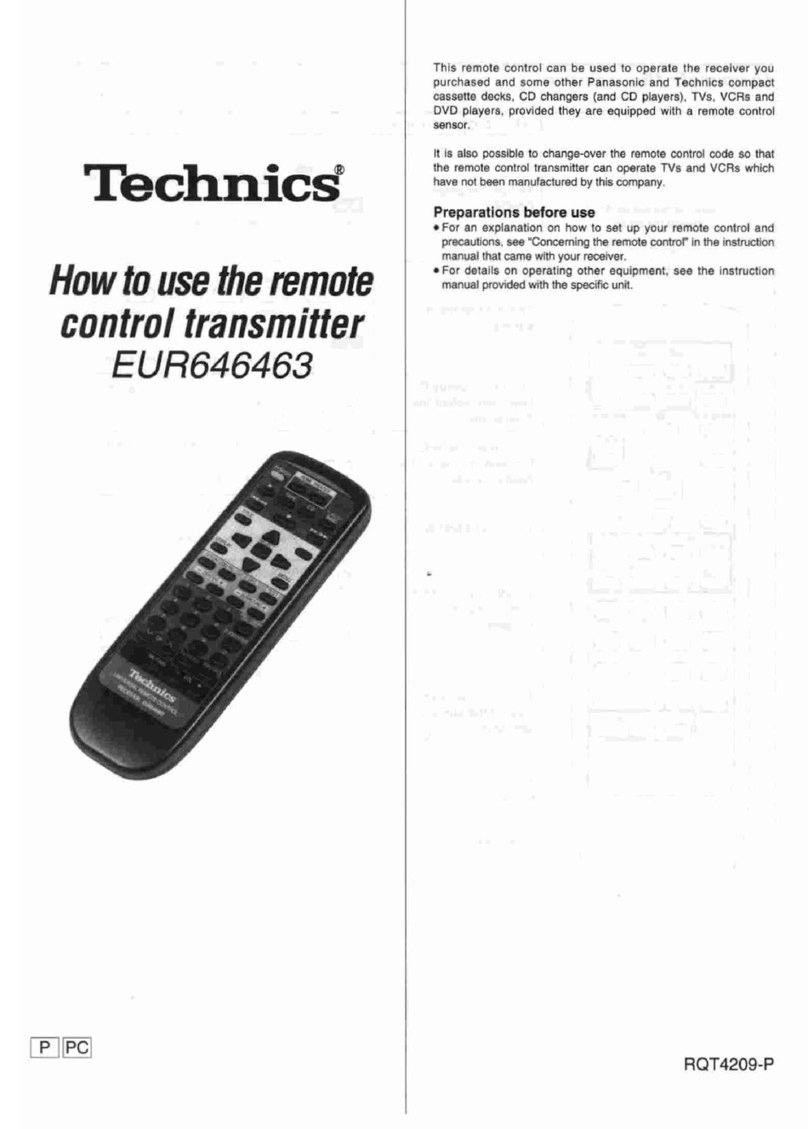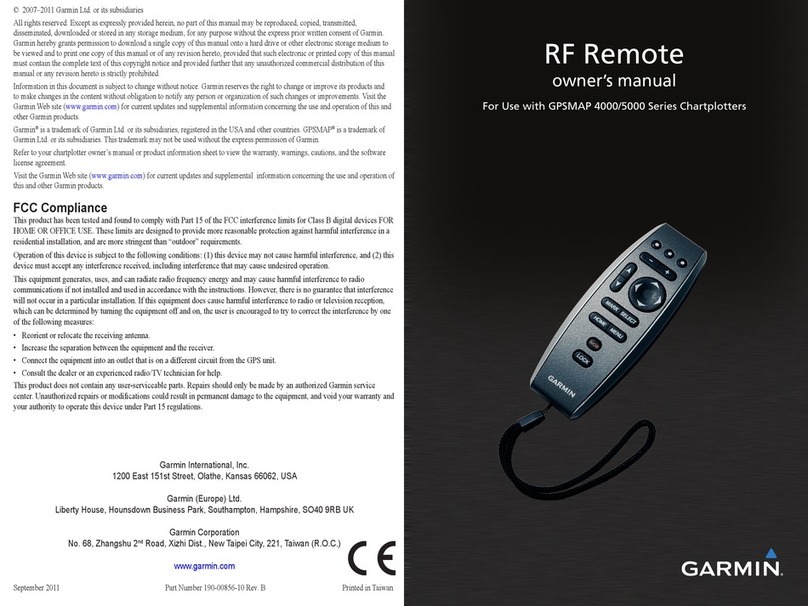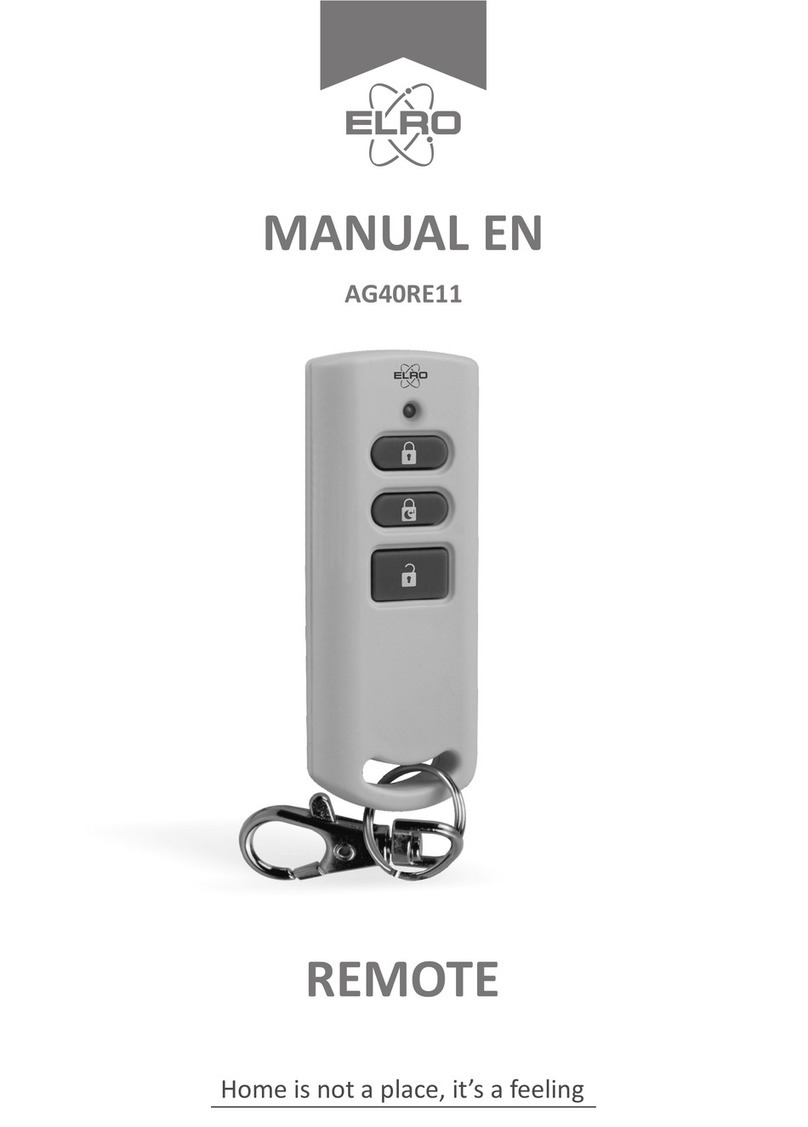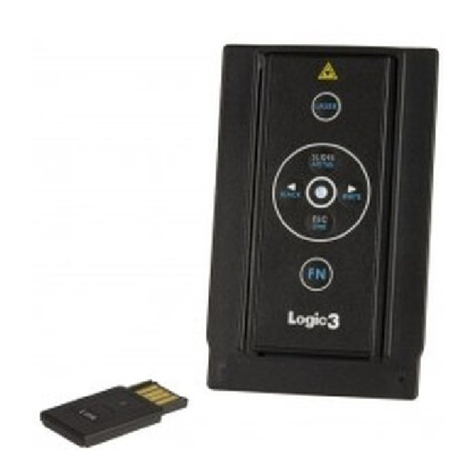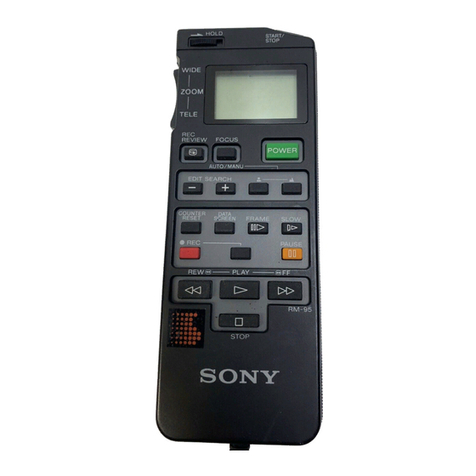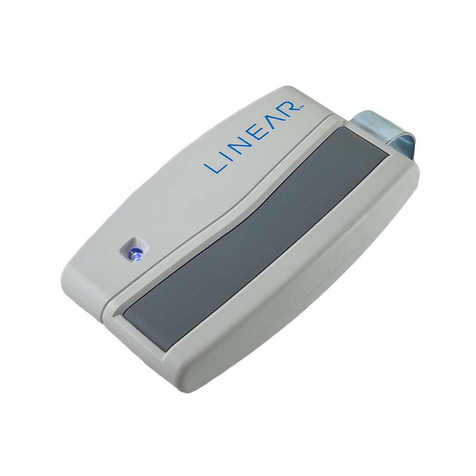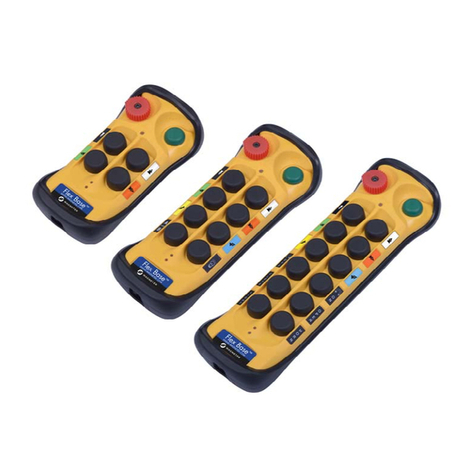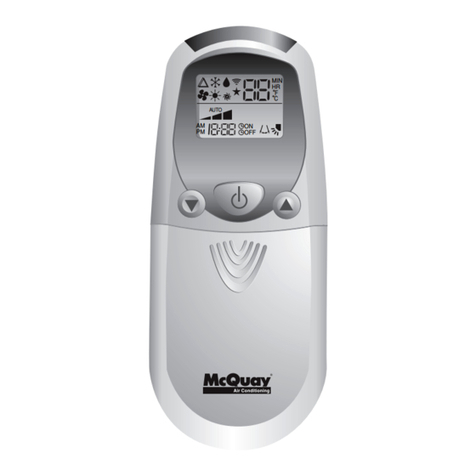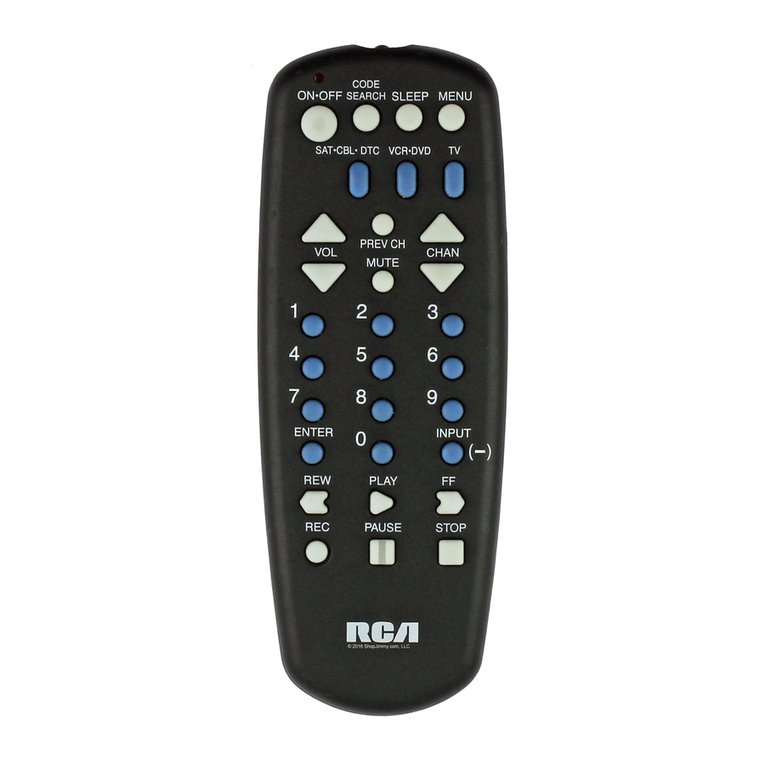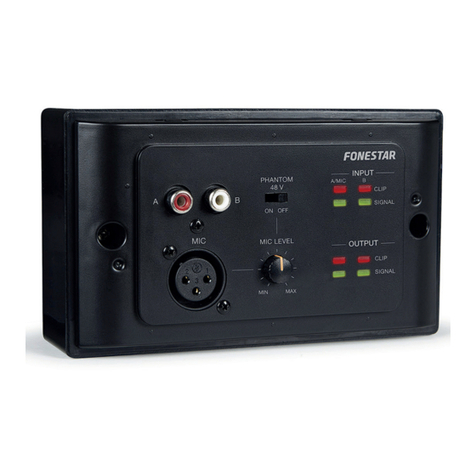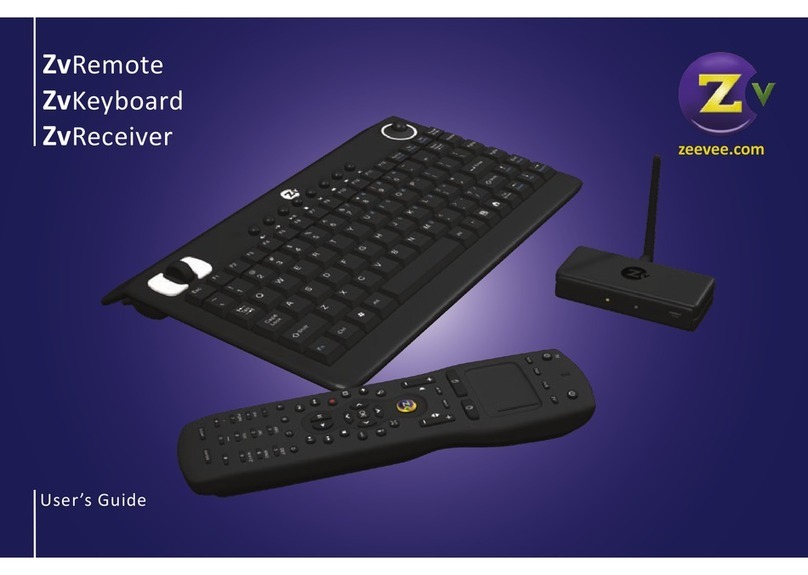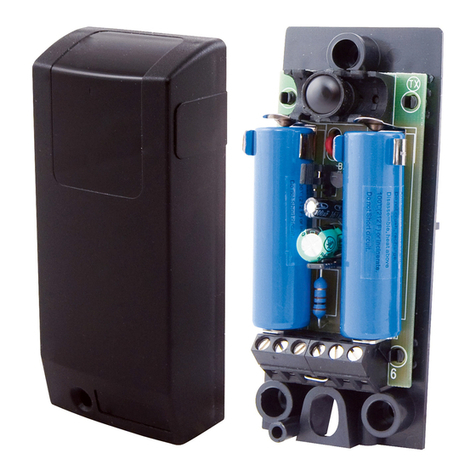DITEC BIX L Series Operating and maintenance manual

DITEC S.p.A.
Via Mons. Banfi, 3 - 21042 Caronno Pertusella (VA) - ITALY
Tel. +39 02 963911 - Fax +39 02 9650314
BIX IP1575
rev. 2004-06-04
Istruzioni d’uso
radiocomando
serie L (433,92
MHz) e serie A
(40,685 MHz)
IGB F D E P
Use instruction for
radio control
serie L (433,92
MHz) and serie A
(40,685 MHz)
Manuel
d’utilisation pour
radiocommandes
série L (433,92
MHz) et serie A
(40,685 MHz)
Bedienungshandbuch
für Fernsteuerung
Serie L (433,92
MHz) und Serie A
(40,685 MHz)
Manual para el
uso del
radiomando
serie L (433,92
MHz) y serie A
(40,685 MHz)
Instruções de uso
do rádio controlo
série L (433,92
MHz) e série A
(40,685 MHz)
PRG SIG J1 L1
ANT
ANT
OUT2
OUT1
OUT1
BIXLR1
BIXLR2
BIXAR2
PRG SIG J1 L1
S1
J2
L2
N.O. 24 V=
N.C. 12V=
J1
CH1
CH2
CH3
CH4
J2
COM
BixMR2
PRG
(only for BIXLP2)
PRG
CH1
CH2
CH1
CH2
CH3
CH4
BIXLP2
BIXLS2
BIXLG4
BIXAG4
PRG PRG
+ 12V -
+ 12V - + 12V -
123456789
10
ON
BIXLS2 BIXLP2
BIXLG4 - BIXAG4
Fig. 1
Fig. 2
Fig. 3
NuovoTX
NewTX Attendere 10 s
Wait for 10 s
CH1
CH2
BixLR2
BixAR2
PRG
NuovoTX
NewTX Attendere 10 s
Wait for 10 s
CH1
CH2
TX già memorizzato
StoredTX (NO BixLS2)
PRG
per 2 s
for 2 s
Fig. 4
Fig. 5
Alimentazione
Power supply
Numero canali
Channels number
N° codici mem
N° memo code
Portata
Range
BixLR1
BixLR2
BixAR2
BixLP2
BixLS2
BixLG4
BixAG4
24 V= / 12 mA
12÷24 V= / 12 mA
12÷24 V= / 12 mA
12 V= / 33 mAh (MN21)
12 V= / 33 mAh (MN21)
12 V= / 33 mAh (MN21)
12 V= / 33 mAh (MN21)
1
2
2
2
2
4
4
200
200
200
-
-
-
-
-
-
-
50÷100 m
50÷100 m
50÷100 m
70÷150 m
Uscita
Output
1 (transistor)
2 (relay 1A / 30V)
2 (relay 1A / 30V)
-
-
-
-

2BIX - IP1575
IAVVERTENZE GENERALI PER LA SICUREZZA
Le presenti avvertenze sono parte integrante ed essenziale del prodotto e
devono essere consegnate all’utilizzatore.
Tenere fuori dalla portata dei bambini i radiocomandi, per evitare che la porta o
cancello motorizzati possa essere azionata involontariamente.
Non usare il radiocomando senza avere la completa visuale della porta o cancello
motorizzati.
I materiali dell’imballaggio (plastica, polistirolo, ecc.) e le batterie non vanno di-
spersi nell’ambiente e non devono essere lasciati alla portata dei bambini in quan-
to potenziali fonti di pericolo.
La manipolazione delle parti elettroniche deve essere effettuata munendosi
di bracciali conduttivi antistatici collegati a terra.
DICHIARAZIONE CE DI CONFORMITÀ
Fabbricante: DITEC S.p.A. - via Mons. Banfi, 3 - 21042 Caronno Pertusella (VA) –
ITALY.
Dichiara che i radiocomandi BixLR1, BixLR2, BixLS2, BixLP2 e BixLG4 (433.92
MHz) e BixAR2 e BixAG4 (40.685 MHz) sono conformi alle condizioni delle se-
guenti direttive CE: Direttiva R&TTE 1999/5/CE, Direttiva EMC 89/336/CEE e Di-
rettiva bassa tensione 73/23/CEE.
Caronno Pertusella, 31-08-2000. Fermo Bressanini
(Presidente)
1. TRASMETTITORE
I radiocomandi serie BIX sono preposti per l’attivazione di automatismi per vani
passaggio e rispondono ai requisiti essenziali stabiliti dalla direttiva 1999/5/CE
R&TTE.
Il trasmettitore è dotato di un codice individuale (Rolling Code) che lo distingue da
qualsiasi altro trasmettitore.
2. RICEVITORE
I ricevitori sono previsti per essere inseriti direttamente nei quadri elettrici DITEC.
Solo i BixLR2 e BixAR2 possono essere usati con la base porta scheda CONT1.
Il ricevitore può ricevere i codici di tutti i trasmettitori, ma attiverà l’uscita di coman-
do solo se il codice ricevuto é presente nella lista dei codici abilitati (max. 200
codici).
Verificare che la memoria BixMR2 sia inserita sul connettore COM del ricevitore
BixLR2/AR2.
Attenzione: l’inserimento e l’estrazione del BixMR2 devono essere effettuati in as-
senza di alimentazione.
I ricevitori BixLR1 e BixLR2 sono dotati di antenna (filo rigido L= 173 mm). In alter-
nativa è possibile collegare l’antenna accordata BixLA.
I ricevitori BixAR2 devono essere collegati all’antenna accordata BixAA.
Per collegare l’antenna al ricevitore usare cavo coassiale RG58 (max. 10 m).
L’antenna va posizionata il più in alto possibile, lontano da strutture metalliche (i
lampeggianti LAMP e LAMPH sono provvisti di antenne per frequenza 433,92 MHz).
3. ABILITAZIONE TRASMETTITORI (Fig. 4)
- Premere il pulsante PRG sul ricevitore (alimentato), il led segnalazione SIG si
accende.
-Solo con BIXLS2. Selezionare mediante i 10 dip-switch il codice di codifica
desiderato, tra i 1024 possibili.
- Effettuare una trasmissione premendo uno qualsiasi dei pulsanti CH del tra-
smettitore (entro la porta del ricevitore alimentato).
Il trasmettitore viene così abilitato. Durante questa fase il led segnalazione
SIG lampeggia. Quando il led torna acceso fisso è possibile abilitare un nuovo
trasmettitore.
Abilitare tutti i nuovi trasmettitori effettuando una trasmissione come indicato
sopra.
N.B.: (Solo con BIXLS2). E’ sufficiente memorizzare un solo TX. Tutti i TX
aventi lo stesso codice sono abilitati.
- L’uscita dalla procedura avviene in modo automatico dopo 10 s dall’ultima
trasmissione oppure premendo nuovamente il tasto PRG (il led SIG si spe-
gne).
4. DUPLICAZIONE NUOVI TRASMETTITORI (Fig. 5)
Per abilitare ulteriori trasmettitori in aggiunta a quelli esistenti, premere PRG di un
trasmettitore già memorizzato (entro la portata del ricevitore alimentato) e premere
uno qualsiasi dei tasti CH del nuovo trasmettitore.
N.B.: Fare attenzione che i trasmettitori dei vicini non vengano memorizzati invo-
lontariamente.
5. SELEZIONE CANALI
Per attivare l’uscita 1 (OUT1) del ricevitore selezionare con il ponticello J1 il canale
desiderato.
Per attivare l’uscita 2 (OUT2) del ricevitore selezionare con il ponticello J2 il canale
desiderato.
Canali preimpostati: CH1 attiva OUT1, CH2 attiva OUT2.
I led L1 e L2 indicano rispettivamente l’attivazione dell’uscita 1 e 2.
6. DISABILITAZIONE DI TUTTI I TRASMETTITORI
- Tenere premuto il pulsante PRG sul ricevitore per 3 s, finché il led SIG comin-
cia a lampeggiare.
- Premere nuovamente il pulsante PRG entro 6 s per confermare l’operazione.
La conferma viene segnalata da un lampeggio del led SIG a frequenza più
elevata.
GENERAL SAFETY PRECAUTIONS
The following precautions are an integral and essential part of the prod-
uct and must be supplied to the user.
Keep remote control out of the reach of children, in order to avoid possible invol-
untary activation of the motorised door or gate.
Do not use remote control out of the visual of the door and gate.
Packaging materials (plastic, polystyrene, etc.) and batteries must not be al-
lowed to litter the environment and must be kept out of the reach of chil-
dren for whom they may be a source of danger.
To handle electronic parts, wear earthed antistatic conductive bracelets.
EC DECLARATION OF CONFORMITY
Manufacturer: DITEC S.p.A. - via Mons. Banfi, 3 - 21042 Caronno Pertusella
(VA) – ITALY.
Herewith declares that the radio controls BixLR1, BixLR2, BixLS2, BixLP2 and
BixLG4 (433.92 MHz) and BixAR2 and BixAG4 (40.685 MHz) are in conformity
with the provisions of the following EC directives: R&TTE Directive 1999/5/EC;
EMC Directive 89/336/EEC and Low Voltage Directive 73/23/EEC.
Caronno Pertusella, 31-08-2000. Fermo Bressanini
(Chairman)
1. TRANSMITTER
The BIX series of remote controls are designed for the activation of automatic
accesses and are built in compliance with the R&TTE Directive, 1999/5/C.
The transmitter is provided with its own code (Rolling code) different from that of
any other transmitter.
2. RECEIVER
Receivers are designed for directly inserting into DITEC electrical boards. Only
the BixLR2 and BixAR2 version can be used with CONT1 card holders.
The receiver can receive the codes from all transmitters but will only respond
upon receiving a code which is included in its file of authorised codes (max. 200
codes).
Check that memory BixMR2 is inserted on COM connector of receiver BixLR2/
AR2.
Attention: Insertion and removal of the BixMR2 module must be made with the
unit powered off.
The receivers BixLR1 and BixLR2 are equipped with a 173 mm long rigid an-
tenna. Alternatively, it may be linked up to a BixLA. The BixAR2 receivers must
be linked up to the BixAA tuned antenna. Tuned antenna by means of an RG58
coaxial cable with a maximum length of 10 metres.
The antenna must be mounted as high up as possible, away from any metal
structures (the LAMP and LAMPH flashing lights are provided with 433,92 MHz
frequency antennas).
3. TRANSMITTERS ENABLING (Fig. 4)
- Press the PRG button on the control panel (powered), and the SIG indicator
LED will light up.
-Only with BIXLS2. Select the desired code among the 1024 possible ones
by means of the 10 dip-switches.
- Carry out a transmission by pressing any of the CH buttons of the transmit-
ter (within the range of the powered receiver).
The transmitter will thus be enabled. During this phase, the SIG indicator
LED flashes. When the LED comes back steady on, a new transmitter can
be enabled.
Enable all the new transmitters by making a transmission as indicated above.
Note: (Only with BIXLS2) Only one TX needs be stored. All the TXs with
the same code will be enabled.
- Exit from the procedure is automatic after 10 s from the last transmission or
by pressing the PRG button again (the SIG LED goes off).
4. DUPLICATION OF NEW TRANSMITTERS (Fig. 5)
To enable other transmitters besides those already existing, without opening the
control panel, press PRG of a transmitter already stored (within the range of the
powered receiver) and press any of the CH buttons of the new transmitter.
Note: be careful that your neighbours’ receivers are not accidentally memorized.
5. CHANNELS SELECTION
Output 1 (OUT1) on the receiver is activated by the selected channel via the
jumper on J1 of the receiver.
Output 2 (OUT2) on the receiver is activated by the selected channel via the
jumper on J2 of the receiver.
Default channels: CH1 actives OUT1, CH2 actives OUT2.
LEDs L1 and L2 signal that output 1 and 2, respectively, have been activated.
6. ALL TRANSMITTERS DISABLING
- Keep the PRG button pressed on the control panel for 3 s, until the SIG LED
starts to flash.
- Press the PRG button again within 6 s to confirm the operation.
Confirmation is signalled by higher frequency flashing of the SIG LED.
GB

3BIX - IP1575
FCONSIGNES GENERALES DE SECURITE
Ces consignes sont partie intégrante et essentielle du produit et doivent
être remises à l’utilisateur.
Garder hors le portée des enfants les radiocommandes afin d’éviter que la porte
ao le portail automatisés puissent être actionnés involontairement.
N’utilisez pas la radiocommande si vous ne voyez pas entièrement la porte au
portail motorisés.
Les matériaux de l’emballage (plastique, polystyrène, etc ne doivent pas être aban-
donnés dans la nature et ne doivent pas être laissés à la portée des enfants, car ils
sont une source potentielle de danger.
N’effectuer la manipulation des parties électroniques qu’après s’être muni
de bracelets conducteurs antistatiques reliés à la terre.
DECLARATION CE DE CONFORMITE
Fabricant: DITEC S.p.A. - via Mons. Banfi, 3 - 21042 Caronno Pertusella (VA) –
ITALY.
Déclare ci-après que les radiocommandes BixLR1, BixLR2, BixLS2, BixLP2 et
BixLG4 (433.92 MHz) et BixAR2 et BixAG4 (40.685 MHz) sont conforme aux dis-
positions des directives CEE suivantes:
Directive R&TTE 1999/5/CE, Directive EMC 89/336/CEE et Directive basse ten-
sion 73/23/CEE.
Caronno Pertusella, 31-08-2000. Fermo Bressanini
(Président)
1. EMETTEUR
Les télécommandes radio de la série BIX permettent d’activer des automatismes
pour les ouvertures de passage et répondent aux exigences essentielles de la
directive 1999/5/CE R&TTE.
L’émetteur est doté d’un code individuel (Rolling Code) qui le distingue de tout
autre émetteur.
2. RECEPTEURS
Les récepteurs sont conçus pour être mis en place directement dans les tableaux
de commande DITEC.
Seul les BixLR2 et BixAR2 peut être utilisé avec les bases porte cartes CONT1.
Le récepteur peut recevoir les codes de tous les émetteurs, mais il n’activera la
sortie de commande que si le code reçu est présent dans la liste des codes auto-
risés (Max. 200 codes).
Vérifier si la mémoire BixMR2 est introduite sur le connecteur COM du récepteur
BixLR2/AR2.
Attention: l’enfichage et l’extraction du module mémoire BIXMR2 doivent s’effec-
tuer sans alimentation.
Les récepteurs BixLR1 et BixLR2 sont doté d’une antenne (fil rigide L = 173 mm).
En alternative, il est possible de relier l’antenne accordée BixLA.
Les récepteurs BixAR2 doivent être reliés à l’antenne accordée BixAA.
Pour relier l’antenne au récepteur, utiliser un câble coaxial RG58 (max. 10 m).
L’antenne doit être installée le plus haut possible, loin de structures métalliques
(les clignotants LAMP et LAMPH sont dotés d'antennes pour fréquence 433,92
MHz).
3. ACTIVATION ÉMETTEURS (Fig. 4)
- Appuyer sur le bouton PRG du récepteur (sous tension), la led de signalisa-
tion SIG s’allume.
-Seulement BIXLS2. Sélectionner le code de cryptage désiré parmi les 1024
codes possibles au moyen des 10 commutateurs DIP.
- Effectuer une transmission en appuyant sur l’un quelconque des boutons CH
du émetteur (à l’intérieur de la portée de récepteur sous tension).
L’émetteur est activé. Pendant cette phase, la led de signalisation SIG cli-
gnote. Quand le voyant redevient fixe, il est possible d’activer le nouvel émet-
teur.
Activer tous les émetteurs en effectuant une transmission comme dit plus
haut.
N.B.: (Uniquement avec BIXLS2). Il suffit de mémoriser un seul émetteur.
Tous les émetteurs ayant le même code sont activés.
- La procédure est automatiquement abandonnée 10 secondes après la der-
nière transmission ou bien si l’on appuie de nouveau sur le bouton PRG (la
led SIG s’éteint).
4. DUPLICATION DE NOUVEAUX EMETTEURS (Fig. 5)
Pour activer de nouveaux émetteurs sans ouvrir l’armoire électrique, appuyer sur
le bouton PRG d’un émetteur déjà mémorisé (à l’intérieur de la portée del récepteur
sous tension) et appuyer sur l’une quelconque des touches CH du nouvel émetteur.
N.B.: Veiller à ne pas mémoriser involontairement les émetteurs des voisins.
5. SÉLECTION CANAUX
La sortie 1 (OUT1) du récepteur est activée par le canal sélectionné par une bar-
rette sur J1.
La sortie 2 (OUT2) du récepteur est activée par le canal sélectionné par une
barrette sur J2.
Canaux préposée: CH1 activé OUT1, CH2 activé OUT2.
Les voyants L1 et L2 indiquent respectivement l’activation de la sortie 1 et 2.
6. DESACTIVATION DE TOUS LES EMETTEURS
- Maintenir enfoncé le bouton PRG situé sur l’armoire électrique pendant 3 s,
jusqu’à ce que la led SIG commence à clignoter.
- Appuyer de nouveau sur le bouton PRG dans les 5 s pour valider l’opération.
La led SIG clignote plus rapidement pour signaler la validation.
ALLGEMEINE SICHERHEITSHINWEISE
Diese Hinweise sind als wesentlicher Bestandteil des Produktes dem
Benutzer auszuhändigen.
Funk-Fernsteuerungen von Kindern fernhalten, damit der Torantrieb nicht
unbeabsichtig ausgelöst werden kann.
Die Fernsteuerung nicht verwenden ob das Tor und das Gittertor nicht sehen.
Das Verpackunsmaterial (Kunststoff, Polystyrol, usw. ) ist vorschriftsmäßig zu
entsorgen.
Es ist von Kindern fernzuhalten, da es eine Gefahr für sie bedeutet.
Eingriffe an den elektronischen Geräten dürfen nur mit antistatischem
geerdeten Armschutz vorgenommen werden.
EG-KONFORMITÄTSERKLÄRUNG
Hersteller: DITEC S.p.A. - via Mons. Banfi, 3 - 21042 Caronno Pertusella (VA) –
ITALY.
Erklärt hiermit, daß die Fernsteuerungen BixLR1, BixLR2, BixLS2, BixLP2 und
BixLG4 (433.92 MHz) und BixAR2 und BixAG4 (40.685 MHz) mit den einschlä-
gigen Bestimmungen folgender EG-Richtlinien übereinstimmen: R&TTE-Richt-
linie 1999/5/EWG, EMC-Richtlinie 89/336/EWG und Niederspannungsrichtlinie
73/23/EWG.
Caronno Pertusella, 31-08-2000. Fermo Bressanini
(Präsident)
1. SENDER
Die Fernsteuerungen der Typenreihe BIX dienen der Aktivierung von Tür- und
Torantrieben und entsprechen den wesentlichen Anforderungen der Richtlinie
1999/5/CE R&TTE.
Der Sender verfügt über einen individuellen Code (Rolling Code), der ihn von
allen anderen unterscheidet.
2. EMPFÄNGER
Die Empfänger sind für den direkten Einbau in die DITEC-Steuerungen vorge-
sehen. Nur die BixLR2 und BixAR2 können mit den Basisports der Platinen
CONT1 verwendet werden.
Der Empfänger kann die Codes aller Sender empfangen, aber aktiviert den
Steuerausgang nur, wenn der empfangene Code in der Liste der aktivierten Co-
des (max. 200) enthalten ist.
Prüfen, dass der Speicher BixMR2 an den COM-Anschluss des Empfängers
BixLR/AR2 angeschlossen ist.
Achtung: Beim Einsetzen und Herausnehmen des Speichermoduls BixMR2 darf
kein Strom zugeführt werden.
Die Empfänger BixLR1 und BixLR2 verfügen über eineAntenne (starrer Draht L
= 173 mm). Als Alternative kann die abgestimmteAntenne BixLA angeschlossen
werden.
Die Empfänger BixAR2 müssen mit der abgestimmten Antenne BixAA verbun-
den werden.
Zum Anschluss der Antenne ein Koaxialkabel RG58 (max. 10 m) verwenden.
Die Antenne muß so hoch als möglich und weit von Metallkonstruktionen ent-
fernt installiert werden (Blinklicht LAMP und LAMPH sind mit 433,92 MHz Anten-
ne vorgesehen).
3. AKTIVIERUNG DER SENDER (Abb. 4)
- PRG-Taste am (mit Strom versorgten) Empfänger drücken, die LED-Anzei-
ge SIG leuchtet auf.
-Nur bei BixLS2. Über die 10 Dip-Schalter die gewünschte Codierung aus
den 1024 möglichen Codes auswählen.
- Führen Sie eine Übertragung durch, indem Sie eine beliebige Taste CH des
Senders drücken (innerhalb der Reichweite der angeschlossenen Empfän-
ger).
Auf diese Weise wird er aktiviert. Während dieser Phase blinkt die Led SIG.
Sobald sie wieder konstant leuchtet, kann ein neuer Sender aktiviert wer-
den.
Alle Sender nach der gleichen Vorgehensweise aktivieren wie obengennant.
Hinweis: (Nur für BIXLS2) Es reicht aus, nur die Sender zu programmie-
ren. Alle Sender mit dem gleichen Code sind aktiviert.
- Das Verfahren wird 10 s nach der letzten Sendung automatisch verlassen
oder durch erneutes Drücken der Taste PRG (die Led SIG löscht ab).
4. DUPLIZIEREN AUF NEUE SENDER (Abb. 5)
Um weitere Sender zusätzlich zu den bestehenden zu aktivieren, wird die PRG-
Taste eines bereits programmierten Senders (innerhalb der Reichweite der mit
Strom versorgten Empfänger) und eine beliebige CH-Taste auf dem neuen Sender
gedrückt.
N.B.: Achten Sie darauf, dass nicht ungewollt die Nachbarsender gespeichert
werden.
5. KANALANWAHL
Der Ausgang 1 (OUT1) wird vom angewählten Kanal mittels Brücke auf J1 akti-
viert.
Der Ausgang 2 (OUT2) wird vom angewählten Kanal mittels Brücke auf J2 akti-
viert.
Vorangelegte Kanäle: CH1 aktiviert OUT1, CH2 aktiviert OUT2. Die Led L1 und
L2 zeigen die Aktivierung jeweils der Ausgänge 1 und 2 an.
6. DEAKTIVIERUNG ALLE SENDER
- Die Taste PRG ca. 3 s drücken, bis die Led SIG zu blinken beginnt.
- Die Taste PRG innerhalb von 6 s zur Bestätigung nochmals drücken.
Die Bestätigung wird von der Led SIG durch schnelleres Blinken angezeigt.
D

4BIX - IP1575
ADVERTENCIAS GENERALES DE SEGURIDAD
Las siguientes advertencias forman parte integrante y esencial del pro-
ducto y deben ser entregadas al usuario.
Conservar fuera del alccance de los niños el telemando para evitar el accionamiento
accidental.
No utilizar el radiomando si no se tiene una visiòn completa de la puerta o de los
portal motorizadas.
El material de embalaje (plàstico, poliestirol, etc.) debe desecharse sin causar
daño al medio ambiente y mantenerse fuera del alcance de los niños, porque es
una potencial fuente de peligro.
La manipulación de las partes electrónicas se tiene que efectuar dotándose
de brazales conductores antiestáticos conectados a tierra.
DECLARACIÓN CE DE CONFORMIDAD
Fabricante: DITEC S.p.A. - via Mons. Banfi, 3 - 21042 Caronno Pertusella (VA) –
ITALY.
Declara que los radiomando BixLR1, BixLR2, BixLS2, BixLP2 e BixLG4 (433.92
MHz) y BixAR2 y BixAG4 (40.685 MHz) son conformes con las condiciones de las
siguientes directivas CE: Directiva R&TTE 1999/5/CE, Directiva EMC 89/336/CEE
y Directiva baja tensión 73/23/CEE.
Caronno Pertusella, 31.08.2000.
Fermo Bressanini
(Presidente)
1. TRANSMISOR
Los radiomandos de serie BIX se utilizan para la activación de aparatos automati-
zados previstos para áreas de paso y están conformes con los requisitos básicos
establecidos por la directiva 1999/5/CE R&TTE. El transmisor posee un código
individual (Rolling Code) que lo distingue de cualquier otro transmisor.
2. RECEPTOR
Los receptores están pensados para ser introducidos directamente en los cuadros
eléctricos DITEC. Solamente BixLR2 y BixAR2 pueden ser usados con las bases
porta-fichas CONT1. El receptor puede recibir los códigos de todos los transmiso-
res, pero activará la salida de mando solamente si el código recibido está presente
en la lista de los códigos habilitados (máx. 200 códigos).
Verificar que la memoria BixMR2 esté insertada en el conector COM del receptor
BixLR2/AR2.
Atención: la inserción y extracción del módulo memoria BixMR2 deben ser efec-
tuadas sin alimentación.
Los receptores BixLR1 y BixLR2 posee una antena (alambre rígido L= 173 mm).
Como alternativa es posible conectar la antena facilitada BixLA. Los receptores
BixAR2 deben ser conectados a la antena sintonizada BixAA.
Para conectar la antena al receptor usar un cable coaxial RG58 (máx.10 m).
La antena ha de ser colocada lo más alto posible, lejos de estructuras metálicas
(los indicadores LAMP y LAMPH son provistos de antenas por frecuencia 433,92
MHz).
3. HABILITACIÓN DE LOS TRANSMISORES (Fig. 4)
- Presionar el pulsador PRG en el receptor (bajo tensión), el led de señaliza-
ción SIG se enciende.
-Sólo con BIXLS2. Seleccionar mediante los 10 conmutadores DIP el código
de codificación deseado entre los 1024 posibles.
- Efectuar una transmisión presionando un pulsador cualquiera CH del nuevo
transmisor (en el interior de la capacidad del receptor alimentado).
De esta manera se habilita el transmisor. Durante esta fase el led señaliza-
ción SIG relampaguea. Cuando el led se enciende de nuevo de forma fija es
posible habilitar un nuevo transmisor.
Habilitar todos los transmisores efectuando una transmisión como dicho mas
arriba.
N.B.: (Sólo con BIXLS2) Basta con memorizar un solo TX. Todos los TX que
poseen los mismos códigos están habilitados.
- La salida de este procedimiento se realiza automática después de 10 segun-
dos desde la última transmisión o bien presionando nuevamente el pulsador
PRG (el led SIG se apaga).
4. DUPLICACION DE NUEVOS EMISORES (Fig. 5)
Para habilitar nuevos emisores, presionar el pulsador PRG de un emisor me-
morizado (en el interior de la capacidad del receptor bajo tensión) y presionar
cualquier tecla CH del emisor nuevo.
N.B.: Tener cuidado a no memorizar involuntariamente los emisores de los vecinos
5. SELECCION DE LOS CANALES
La salida 1(OUT1) del receptor se activa a través del canal seleccionado mediante
un conector puente en J1.
La salida 2 (OUT2) del receptor se activa a través del canal seleccionado median-
te un conector puente en J2.
Canales preseleccionados: CH1 activa OUT1, CH2 activa OUT2.
Los led L1 y L2 indican respectivamente la activación de la salida 1 y 2.
6. DESHABILITACION DE TODOS LOS EMISORES
- Mantener pulsado el botón PRG en el receptor, para 3 segundos hasta que el
led SIG empiece a relampaguear.
- Pulsar nuevamente el botón PRG antes de que pasen 6 segundos para con-
firmar la operación. La confirmación se señala con un destello del led SIG con
una frecuencia más elevada
E P
ADVERTÊNCIAS GERAIS PARA A SEGURANÇA
As presentes advertências são parte integrante e essencial do produto e
devem ser entregues ao utilizador.
Guardar fora do alcance de crianças os rádio controlos para evitar que a porta ou
portão motorizados possa ser accionada involuntariamente.
Não use o rádio controlo sem ter a completa visual da porta ou portão motorizados.
Os materiais da embalagem (plástico, poliestireno, etc…) não são jogados no
meio ambiente e não devem ser deixados ao alcance de crianças, pois potenciais
fontes de perigo.
A manipulação das partes electrónicas deve ser efectuada munindo-se de
braçadeiras condutoras anti estáticas ligadas a terra.
DECLARAÇÃO DO FABRICANTE
Fabricante: DITEC S.p.A.- via Mons. Banfi, 3 - 21042 Caronno P.lla (VA) - ITALY
Declara que rádio controlos BixLR1, BixLR2, BixLS2, BixLP2 e BixLG4 (433.92
MHz) e BixAR2 e BixAG4 (40.685 MHz) seja conforme as condições das seguin-
tes outras directrizes CE: Directriz R&TTE 1999/5/CE, Directriz EMC 89/336/CEE
e Directriz de tensão baixa 73/23/CEE.
Caronno Pertusella, 31-08-2000.
Fermo Bressanini
(Presidente)
1. TRANSMISSOR
Os rádios controlos série BIX são previstos para a activação de automatismos
para vãos de passagem e respondem aos requisitos essenciais estabelecidos
pela directriz 1999/5/CE R&TTE.
O transmissor é equipado de um código individual (Rolling Code)
que o distingue de qualquer outro transmissor.
2. RECEPTOR
Os receptores são previstos para ser introduzidos directamente nos quadros
eléctricos DITEC. Somente os BixLR2 e BixAR2 podem ser utilizados com a base
porta-placa CONT1.
O receptor pode receber os códigos de todos os transmissores, mas, activará a
saída de comando só se o código recebido é presente na lista dos códigos
habilitados (200 códigos máx.).
Verifique que a memória BixMR2 esteja introduzida no conector
COM do receptor BixLR2/AR2.
Atenção: a introdução e a extracção do BixMR2 devem ser efectuadas na ausência
de alimentação.
Os receptores BixLR1 e BixLR2 são equipados de antena (fio rígido L= 173 mm).
Em alternativa é possível ligar a antena regulada BixLA.
Os receptores BixAR2 devem ser ligados na antena regulada
BixAA.
Para ligar a antena ao receptor, usar o cabo coaxial RG58 (10 m máx.).
A antena deve ser posicionada o mais alto possível, longe de estruturas metálicas
(as lâmpadas LAMP e LAMPH são equipadas de antenas para frequência 433,92
MHz).
3. HABILITAÇAO DOS TRANSMISSORES (Fig. 4)
- Carregar o botão PRG no receptor (alimentado), o led de sinalização SIG se
acende.
-(Somente com BixLS2). Seleccionar mediante os 10 dip-switch o código de
codificação desejado, entre os 1024 possíveis.
- Efectuar uma transmissão carregando a tecla CH desejada do transmissor
(dentro da capacidade do receptor alimentado).
O transmissor é assim habilitado. Durante esta fase o led de sinalização SIG
pisca. Quando o led retorna aceso de modo fixo é possível habilitar um novo
transmissor.
Habilitar todos os novos transmissores efectuando uma transmissão como
indicado acima.
OBS.: (Somente com o BixLS2) É suficiente memorizar somente um TX.
Todos os TX com o mesmo código são habilitados.
- A saída do procedimento realiza-se de modo automático depois de 10 seg.
desde a última transmissão ou carregando novamente o botão PRG (o led
SIG se apaga).
4. DUPLICAÇÃO DE NOVOS TRANSMISSORES (Fig. 5)
Para habilitar mais transmissores em adição aos existentes, carregar PRG de um
transmissor já memorizado (dentro da capacidade do receptor alimentado) e
carregar qualquer uma das teclas CH do novo transmissor.
OBS.: Prestar atenção que os transmissores dos vizinhos não sejam memorizados
involuntariamente.
5. SELECÇÃO DOS CANAIS
Para activar a saída 1 (OUT1) do receptor seleccionar com a
ponte J1 o canal desejado.
Para activar a saída 2 (OUT2) do receptor seleccionar com a
ponte J2 o canal desejado.
Canais pré-definidos: CH1 activa OUT1, CH2 activa OUT2.
Os led L1 e L2 indicam respectivamente a activação da saída 1 e 2.
6. DESACTIVAR DE TODOS TRANSMISSORES
- Manter carregado o botão PRG no Q.E. por 3 seg., até quando o led SIG
começa a piscar.
- Carregar novamente o botão PRG dentro de 6 seg. para confirmar a operação.
A confirmação é sinalizada por um piscar do led SIG a frequência mais elevada.
This manual suits for next models
8
Other DITEC Remote Control manuals
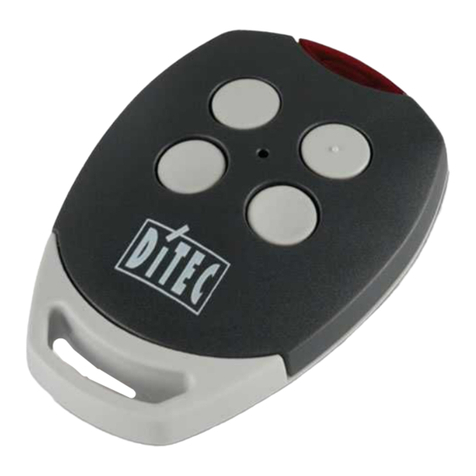
DITEC
DITEC Gol4C Owner's manual

DITEC
DITEC Bixa G4 Owner's manual
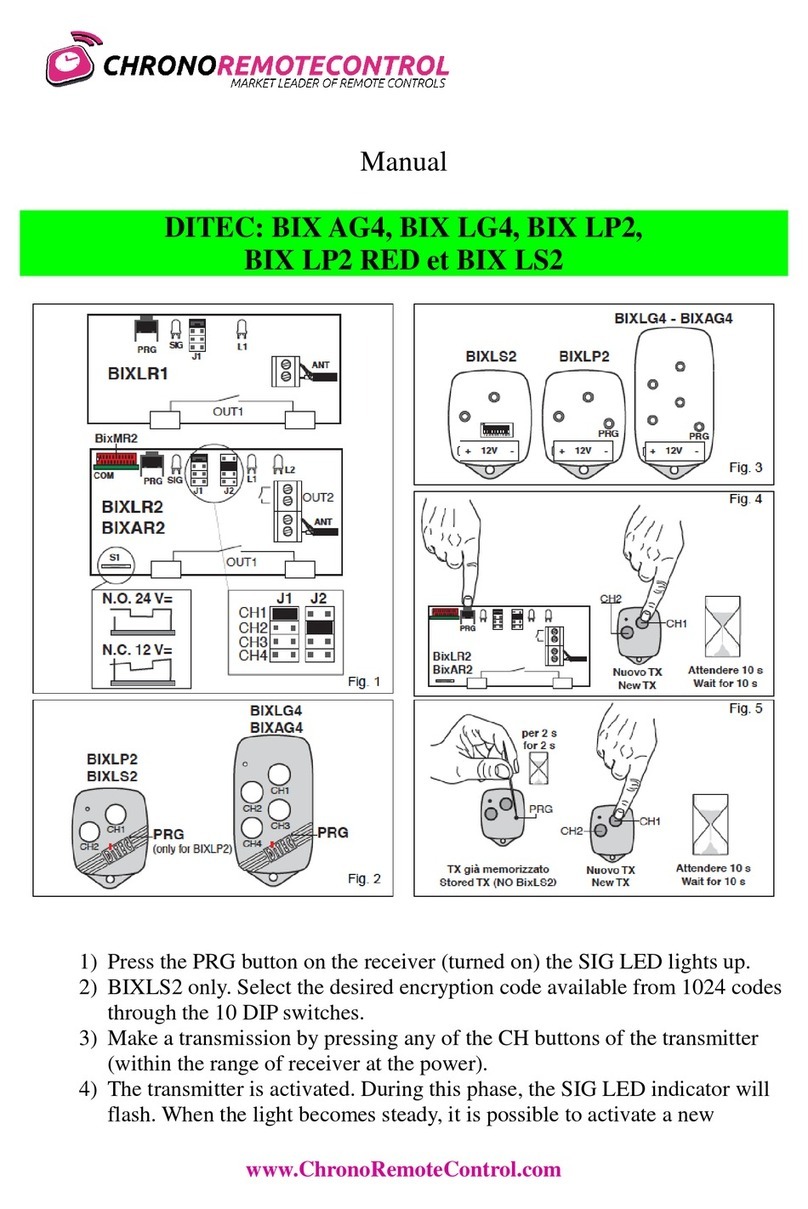
DITEC
DITEC BIX AG4 User manual
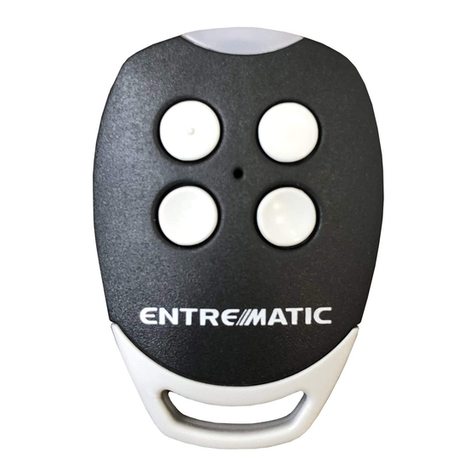
DITEC
DITEC GOL4 User manual
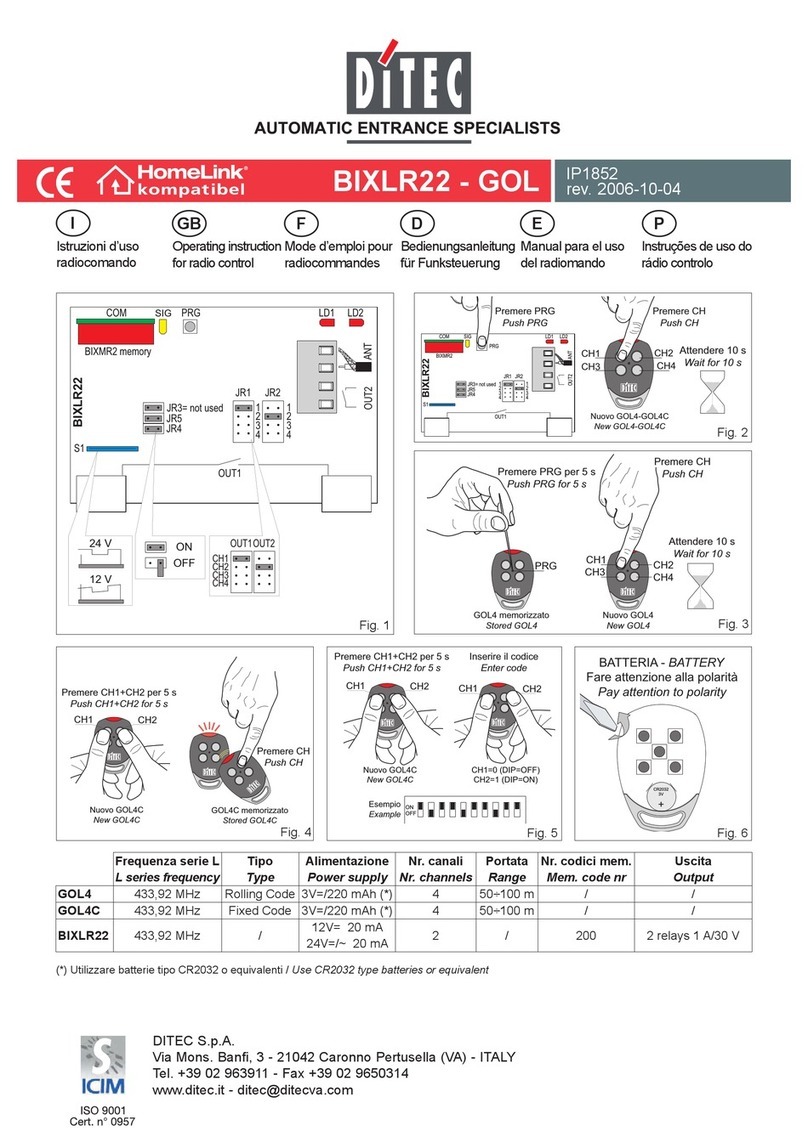
DITEC
DITEC BIXLR22-GOL User manual
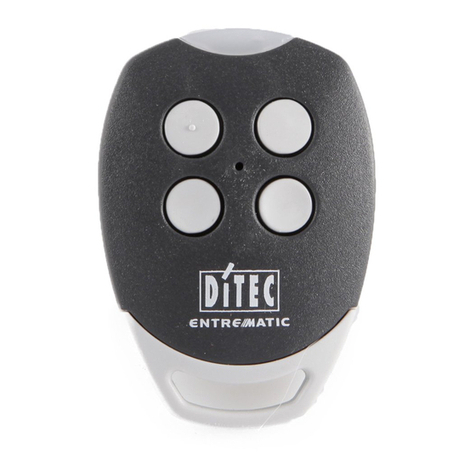
DITEC
DITEC GOL4-C Owner's manual

DITEC
DITEC BIXLR22-GOL User manual
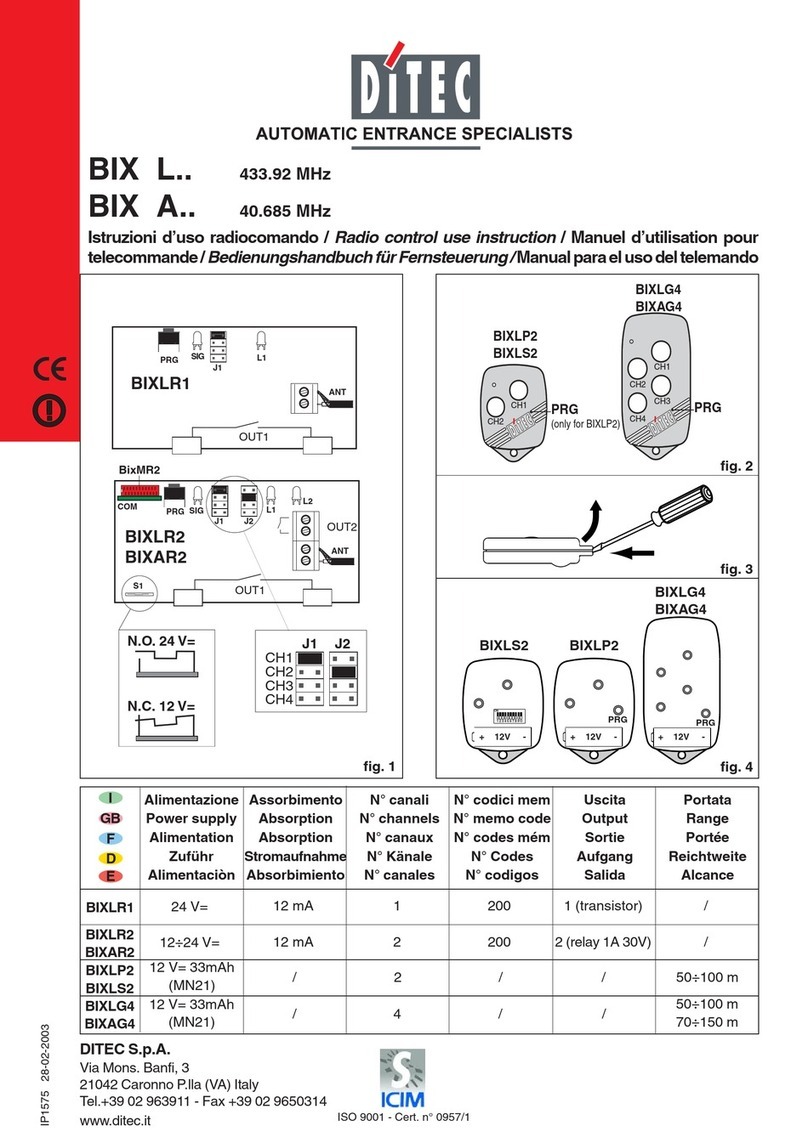
DITEC
DITEC BIX L Series Operating and maintenance manual
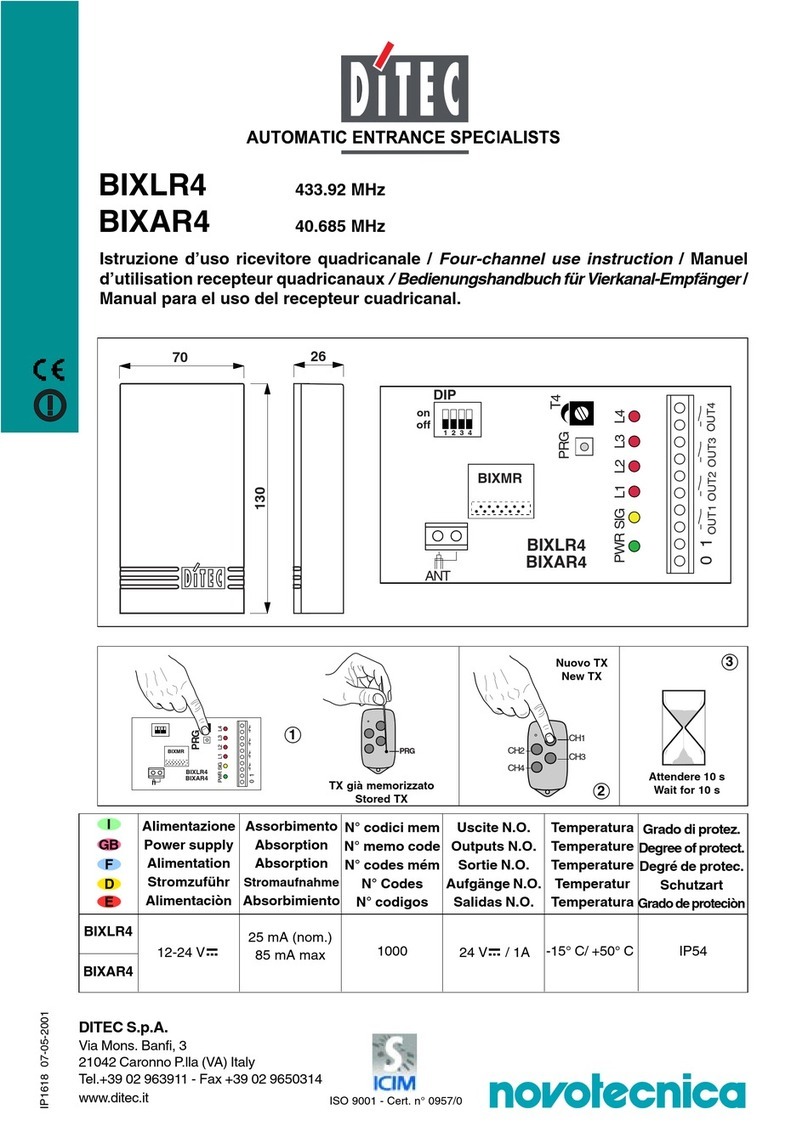
DITEC
DITEC BIXLR4 Quick guide

